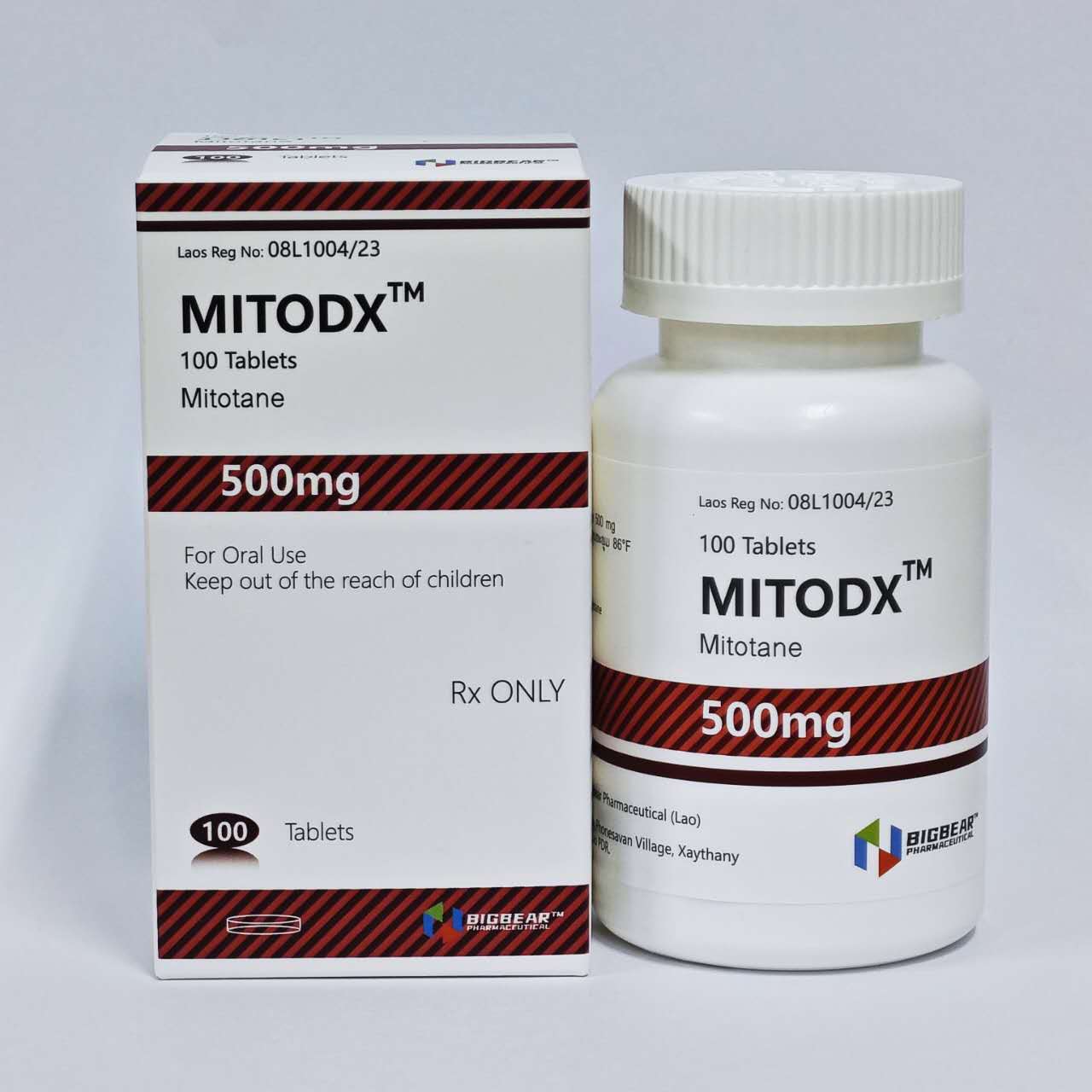MITODX,Mitotane 500mg
Manufactor:Bigbear Pharmaceutical Laos
Introduction:Mitotane, also known as Phenylthiocarbamide, Totimamine (O, P‘-DDD), is a kind of adrenal cortexenoma (ACC) and libraries for the treatment of adrenal cortexomas (ACC) and libraries Drugs of Xin‘s Syndrome. It is an organic compound that has the function of inhibiting adrenal hormone synthesis. Mittan was originally synthesized by German chemist Gerhard Schindler in 1942, and was introduced clinically to treat adrenal glandular tumors in 1959.
chat onlinePhone: +8562052137046
Recommended
- details
【Drug Name】
Name:Mitotane Tablets
Product Name: MITODX
【Specification】500mg
【Indications】
MITODX is indicated for the treatment of patients with inoperable, functional or
nonfunctional, adrenal cortical carcinoma.
【Recommended Dosage】
The recommended initial dose of MITODX is 2 g to 6 g orally, in three or four divided doses per day. Increase doses incrementally to achieve a blood concentration of 14 to 20 mg/L, or as tolerated.
MITODX is a cytotoxic drug. Follow applicable special handling and disposal procedures.
Adrenal Crisis in the Setting of Shock or Severe Trauma
Discontinue MITODX until recoveryCentral Nervous System (CNS) Toxicity
Discontinue MITODX until symptoms resolve. Seven to 10 days after symptoms resolve, restart at a lower dose (for example, decrease by 500-1000 mg)
【Side Effects】
Adrenal Crisis in the Setting of Shock or Severe Trauma
In patients taking MITODX, adrenal crisis occurs in the setting of shock or severe trauma and
response to shock is impaired. Administer hydrocortisone, monitor for escalating signs of shock,
and discontinue MITODX until recovery.
CNS Toxicity
CNS toxicity, including sedation, lethargy, and vertigo, occurs with MITODX treatment. Mitotane plasma concentrations exceeding 20 mcg/mL are associated with a greater incidence of toxicity.
Adrenal Insufficiency
Treatment with MITODX can cause adrenal insufficiency. Institute steroid replacement as clinically indicated. Measure free cortisol and corticotropin (ACTH) levels to achieve optimal steroid replacement.
Embryo-Fetal Toxicity
MITODX can cause fetal harm when administered to a pregnant woman.Abnormal pregnancy outcomes, such as preterm births and early pregnancy loss, can occur in patients exposed to mitotane during pregnancy. Advise pregnant women of the potential risk to a fetus. Advise females of reproductive potential to use effective contraception during treatment with MITODX and after discontinuation of treatment for as long as mitotane plasma levels are detectable
Ovarian Macrocysts in Premenopausal Women
Ovarian macrocysts, often bilateral and multiple, have been reported in premenopausal patients receiving MITODX. Complications from these cysts, including adnexal torsion and hemorrhagic cyst rupture, have been reported. In some cases, improvement after mitotane discontinuation has been described. Advise female patients to seek medical care if they experience gynecological symptoms such as vaginal bleeding and/or pelvic pain.
ADVERSE REACTIONS
The following adverse reactions are discussed in greater detail in other sections of the label:
· Adrenal Crisis in the Setting of Shock or Severe Trauma
· CNS Toxicity
·Adrenal Insufficiency
· Ovarian macrocysts
The following adverse reactions associated with the use of MITODX were identified in clinical trials or postmarketing reports. Because these reactions were reported voluntarily from a population of uncertain size, it is not always possible to estimate their frequency reliably or to establish a causal relationship to drug exposure.
Common adverse reactions occurring with MITODX treatment include:
· Anorexia, nausea, vomiting, and diarrhea (80%)
· Depression, dizziness, or vertigo (15%-40%)
· Rash (15%)
· Neutropenia
· Growth retardation, hypothyroidism
· Confusion, headache, ataxia, mental impairment, weakness, dysarthria
· Maculopathy
· Hepatitis, elevation of liver enzymes
· Gynecomastia
· Hypercholesterolemia, hypertriglyceridemia
· Decreased blood androstenedione and decreased blood testosterone in females, increased sex hormone binding globulin in females and males, decreased blood free testosterone in males.
Less common adverse reactions include: visual blurring, diplopia, lens opacity, retinopathy, prolonged bleeding time, hematuria, hemorrhagic cystitis, albuminuria, hypertension, orthostatic hypotension, flushing, generalized aching, and fever.
【Storage】
Store bottles at 25°C (77°F); excursions permitted between 15°C and 30°C (59°F-86°F).
Keep MITODX and all medicines out of the reach of children.

 中文
中文
